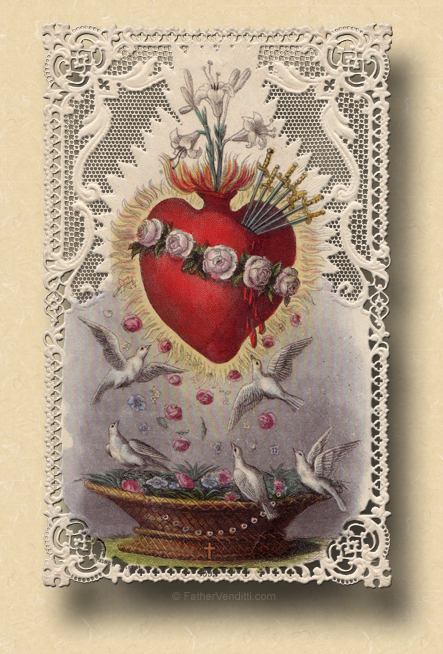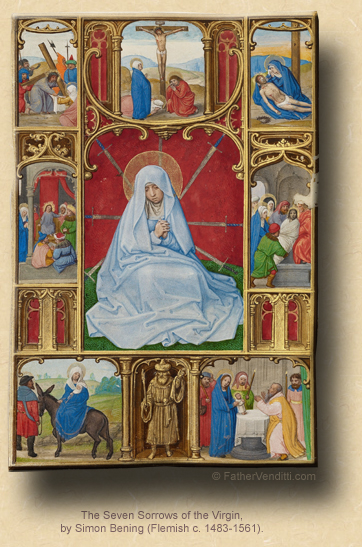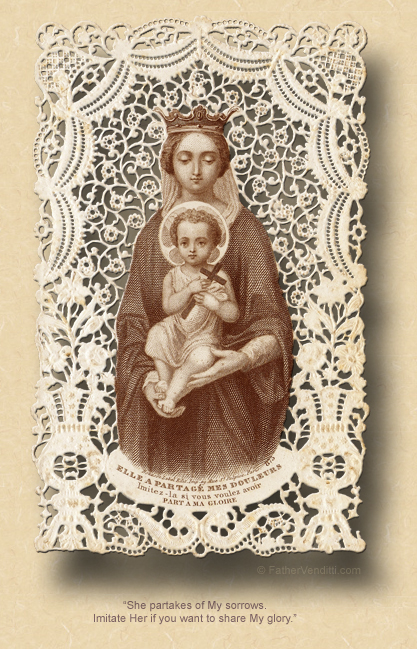The Seven Sorrows of Our Lady, and the Eight Footnotes to a Short, Weekday Homily.
The Memorial of Our Lady of Sorrows.
Lessons from the proper, according to the ordinary form of the Roman Rite:*
• Hebrews 5: 7-9.
• Psalm 31: 2-6, 15-16, 20.
• [Optional Sequence] Stabat Mater dolorósa…**
• John 19: 25-27.
[or, Luke 2: 33-35].
|
…or, first & second lessons from the secondary feria:
• I Corinthians 15: 1-11.
• Psalm 118: 1-2, 16-17, 28.
…the sequence remaining optional and the third lesson from the proper as above being required.
|
The Second Class Feast of the Seven Sorrows of the Blessed Virgin Mary; and, the Commemoration of Saint Nicomedes, Martyr.***
Lessons from the proper, according to the extraordinary form of the Roman Rite:
• Judith 13: 22-25.
• [Gradual] "Dolorosa et lacrimábilis…"†
• [Tract] Stabat sancta María cœli Regina…††
• [Sequence] Stabat Mater dolorósa…**
• John 19: 25-27.
|
If a Mass for the commemoration is taken, lessons from the common "In virtúte…" of a Martyr not a Bishop:†††
• Wisdom 10: 10-14.
• Psalm 111: 1-2.
• Matthew 10: 34-42.
|
The Friday of the Holy Cross (the Fourteenth after Pentecost); the Feast of the Holy & Great Martyr Nicetas; and, the Feast of Our Venerable Father Symeon, Archbishop of Thessalonica.‡
First & third lessons from the pentecostarion, second & fourth from the menaion for the Martyr, according to the Ruthenian recension of the Byzantine Rite:
• Galatians 4: 8-21.
• II Timothy 1-10.
• Mark 6: 45-53.
• Matthew 10: 16-22.
FatherVenditti.com
|
 7:24 AM 9/15/2017 — Today's memorial, Our Lady of Sorrows, used to be—and still is in the extraordinary form of the Roman Rite—the Second Class Feast of the Seven Sorrows of the Blessed Virgin Mary. I'm not altogether sure how the commemoration is improved by making it non-specific, as devotion to the Seven Sorrows has a long history in the Church. While the feast wasn't placed on the Church's universal calendar until 1814 by Pope Pius VII, it was already being celebrated locally in many places for a long time as a liturgical outpouring of what was already a very popular devotion on the part of the faithful. 7:24 AM 9/15/2017 — Today's memorial, Our Lady of Sorrows, used to be—and still is in the extraordinary form of the Roman Rite—the Second Class Feast of the Seven Sorrows of the Blessed Virgin Mary. I'm not altogether sure how the commemoration is improved by making it non-specific, as devotion to the Seven Sorrows has a long history in the Church. While the feast wasn't placed on the Church's universal calendar until 1814 by Pope Pius VII, it was already being celebrated locally in many places for a long time as a liturgical outpouring of what was already a very popular devotion on the part of the faithful.
The Seven Sorrows—or Dolors—of our Lady are all taken from Holy Scripture: the prophecy of Simeon from Luke 2, the flight into Egypt from Matthew 2, the loss of the Child Jesus in the temple from Luke 3, the meeting of Jesus and Mary on the Way of the Cross, the crucifixion, the taking down of the Body of Jesus from the Cross, and the burial of our Lord. The good Saint Bridget, who spread this devotion, informs us that there are also seven graces the Mother of God promises to those who meditate on Her Seven Sorrows: peace in their family life, understanding of Divine mysteries, consolation in their sufferings, easier abandonment to the holy Will of God, defense against the assaults of the Devil, help at the moment of death, and a special advocacy when standing before the throne of judgment.
As you can see, the Seven Dolors bear close resemblance to the fourteen Stations the Cross; a few of them are the same. And it is not a coincidence that this observance follows directly after the Feast of the Exaltation of the Holy Cross; for, how can we contemplate the scene of the Crucifixion of our Blessed Lord without being conscious of our Mother and His as she weeps at the foot of the Holy Cross, and see our Blessed Mother as the chief example of how to process the Passion of our Lord in our prayers: with love, with resignation and with complete abandonment to the Divine Will? We can only do so with the hope—as we will pray in today's Post-Communion Prayer—“that, honoring how the Blessed Virgin Mary suffered with Her Son, we may contemplate, in the sufferings of Christ, what is lacking in ourselves.”‡‡

* On this memorial, the third lesson from the proper, for which there are two options, is always required, with the first and second lessons taken from either the proper or the secondary feria as indicated. In either case, the Sequence remains optional (in the extraordinary form, the Sequence is required). No lessons from any common are indicated.
 ** At the Cross her station keeping, ** At the Cross her station keeping,
stood the mournful Mother weeping,
close to her Son to the last.
Through her heart, His sorrow sharing,
all His bitter anguish bearing,
now at length the sword has passed.
O how sad and sore distressed
was that Mother, highly blest,
of the sole-begotten One.
Christ above in torment hangs,
she beneath beholds the pangs
of her dying glorious Son.
Is there one who would not weep,
whelmed in miseries so deep,
Christ's dear Mother to behold?
Can the human heart refrain
from partaking in her pain,
in that Mother's pain untold?
For the sins of His own nation,
She saw Jesus wracked with torment,
All with scourges rent:
She beheld her tender Child,
Saw Him hang in desolation,
Till His spirit forth He sent.
O thou Mother! fount of love!
Touch my spirit from above,
make my heart with thine accord:
Make me feel as thou hast felt;
make my soul to glow and melt
with the love of Christ my Lord.
Holy Mother! pierce me through,
in my heart each wound renew
of my Savior crucified:
Let me share with thee His pain,
who for all my sins was slain,
who for me in torments died.
Let me mingle tears with thee,
mourning Him who mourned for me,
all the days that I may live:
By the Cross with thee to stay,
there with thee to weep and pray,
is all I ask of thee to give.
Virgin of all virgins blest!,
Listen to my fond request:
let me share thy grief divine;
Let me, to my latest breath,
in my body bear the death
of that dying Son of thine.
Wounded with His every wound,
steep my soul till it hath swooned,
in His very Blood away;
Be to me, O Virgin, nigh,
lest in flames I burn and die,
in His awful Judgment Day.
Christ, when Thou shalt call me hence,
be Thy Mother my defense,
be Thy Cross my victory;
While my body here decays,
may my soul Thy goodness praise,
Safe in Paradise with Thee.
[Translation by Edward Caswall, Lyra Catholica, 1849.]
 *** In the extraordinary form of the Roman Rite, the Seven Sorrows of Mary are commemorated liturgically twice: once on the Friday of Passion Week, and once today. The Masses on both days are practically identical, except for the addition of the Sequence today. *** In the extraordinary form of the Roman Rite, the Seven Sorrows of Mary are commemorated liturgically twice: once on the Friday of Passion Week, and once today. The Masses on both days are practically identical, except for the addition of the Sequence today.
St. Nicomedes, a priest of Rome, was scourged to death under Domitian in the first century. If a High Mass is offered for the Seven Sorrows, the commemoration of St. Nicomedes is not made, and a second Low Mass for the saint might be offered for a serious reason; if, however, a Low Mass is offered for the feast, the commemoration of the saint is made by an additional Collect, Secret and Postcommunion added to those of the feast, and a Mass just for the saint is not permitted. Cf. the footnote ††† below.
† The Gradual is non-Scriptural: "Thou art full of sorrow and of tears, O Virgin Mary, standing near the cross of the Lord Jesus, Thy Son, the Redeemer. O Virgin Mother of God, He whom the whole world doth not contain, beareth this torment of the cross, the Author of life made man."
†† The Tract is non-Scriptural: "Holy Mary, the Queen of heaven and Mistress of the world, stood by the cross of our Lord Jesus, full of sorrows. 'O all ye that pass by the way, attend, and see if there be any sorrow like to my sorrow' (Lam. 1: 12)."
††† Ordinarily, a Mass solely for a commemoration coinciding with a second class feast would not be permitted; however, such a Mass might possibly be offered as indicated for a serious reason, such as if the parish is named for the saint, but it would have to be a Low Mass and could not be the only Mass of the day, with the presumption that the Mass for the second class feast is a High Mass in which the usual commemoration is not made as described in footnote *** above.
The ordinary form, for the most part, solves this difficulty by allowing a memorial honoring the patron of the parish to be promoted to the rank of a solemnity in that parish only, but such promotions do not occur in the extraordinary form. For a thorough treatment of how commemorations are handled in the extraordinary form, cf. the post here.
‡ Nicetas was born and educated in the country of the Goths near the River Danube. After his martyrdom, his body was transferred to Mopsuestia in Asia Minor, then to Venice.
Symeon was archbishop of Thessalonica from 1416 or 1417, until his death in 1429.
‡‡ This is my own translation, based on the Latin text. The translation of this prayer in the Roman Missal Third Edition is confusing, and seems to indicate, by the way the clauses are ordered, that there is something lacking in the sufferings of Christ.
|

